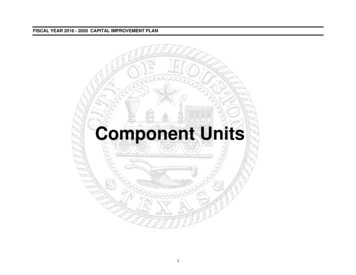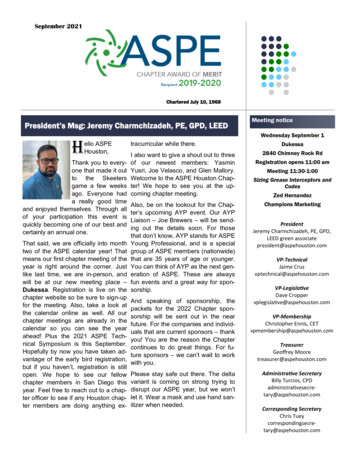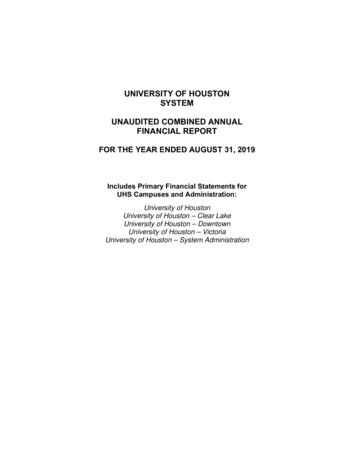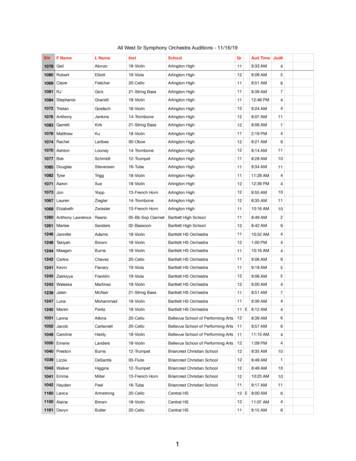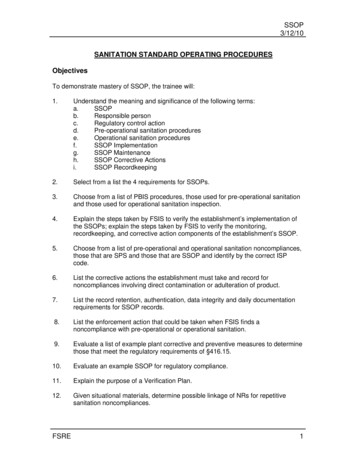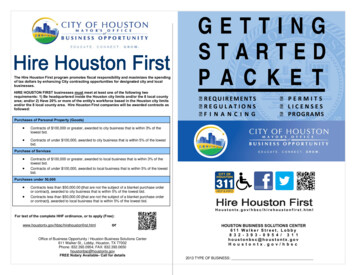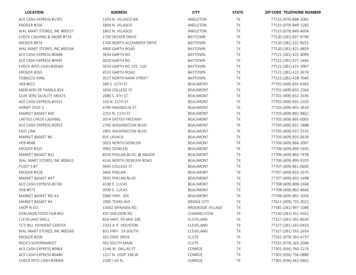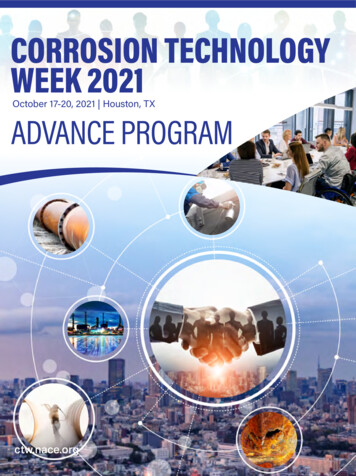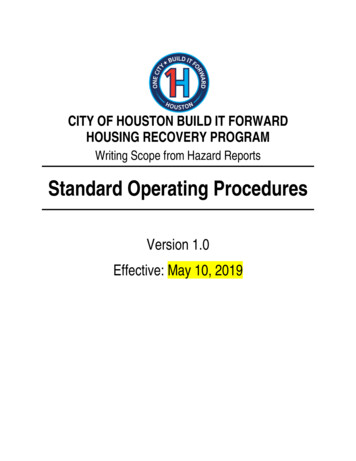
Transcription
CITY OF HOUSTON BUILD IT FORWARDHOUSING RECOVERY PROGRAMWriting Scope from Hazard ReportsStandard Operating ProceduresVersion 1.0Effective: May 10, 2019
Version 1.0, March 26, 2019Table of ContentsAcronyms/Abbreviations List . 3Purpose. 4Additional Authority . 4Scope . 4Responsible Parties . 4Data and Records Management . 4Background . 5Hazard Reports Relevant Terms. 5Procedures for Adding Scope based on the results Hazard Testing. 6Deriving Scope from the Limited Asbestos Survey . 7Asbestos (ACM) Interior Guidelines . 7Asbestos (ACM) – Exterior Guidelines . 10Deriving Scope from the Lead Based Paint Risk Assessment. 11Background on Lead Based Paint (LBP) . 11Lead-Based Paint (LBP) Interior Guidelines. 12Lead-Based Paint (LBP) - Exterior Guidelines . 15Deriving Scope from a Mold Remediation Report . 17Version History. 20
Version 1.0, March 26, 2019Acronyms/Abbreviations ListACMAsbestos Containing MaterialBIFHBuild It Forward HoustonCDBGCommunity Development Block GrantCDBG-DRCommunity Development Block Grant-Disaster RecoveryCFRCode of Federal Regulations(the) CityCity of Houston, TexasCOCCertificate of ComplianceECREstimated Cost to RepairGLOTexas General Land OfficeGPSGlobal Positioning SystemHCDDHousing and Community Development DepartmentHbAPHomebuyer Assistance ProgramHoAPHomeowner Assistance ProgramHUDU.S. Department of Housing and Urban DevelopmentHQSHousing Quality Standard(s)HVACHeating, Ventilation, and Air ConditioningIMSInformation Management SystemsISIInitial Site AssessmentLBPLead Based PaintLSHRLead Safe Housing RulePACMPresumed Asbestos Containing MaterialQAQuality AssuranceQCQuality ControlROERight of EntryRRPRenovation, Repair, and PaintingSEIFSite Evaluation and Inspection FormSFHDSingle-Family Housing Development programSOPStandard Operating Procedure(s)SOWScope of WorkSRPSmall Rental ProgramSSERSite-Specific Environmental ReviewU.S.C.United States Code
Version 1.0, March 26, 2019XMXactimatePurposeThis SOP describes the process of reviewing hazard reports and adding scope to files to ensurethat step-by-step actions and decision-making processes are consistently followed. The SOP issubject to periodic revisions to improve efficiency and as otherwise determined to beappropriate by the Program. Each version of the SOP is authorized by BIFH for implementationupon its date of distribution.Additional AuthorityFeasibility determinations completed for BIFH housing recovery programs are to be consistentwith HUD Housing Quality Standards (HQS) and in compliance with State and localrequirements for residential buildings.ScopeThis SOP describes the process to review hazard reports and add appropriate scope to theXactimate ECR to address any identified hazards following a Lead Risk Assessment, LimitedAsbestos Survey, or Mold Remediation Plan. The judgement of a certified abatement orremediation professional shall supersede any specific scope that appears in a programgenerated scope of work. The Scope of work shall follow known best practices to effectivelyestimate the cost of remediation or abatement activity, however the General Contractor andtheir subcontracted firms shall be responsible for ensuring that homes are properlyrehabilitiated.Responsible PartiesCity of Houston Housing and Community Development Department (HCDD)HCDD Disaster Recovery DivisionBuild it Forward Policy Control BoardData and Records ManagementHCDD maintains data and records for BIFH housing recovery programs through its designatedInformation Management System (IMS) of record. Initial Feasibility Reports, DOB analyses, andrecords of requesting hazards tests will be documented with the IMS.
Version 1.0, March 26, 2019BackgroundThis SOP is part of a linear series of Inspection and Construction Management SOPs as follows: Environmental ReviewInspectionQC of Inspection DeliverablesFlood Plain Evaluation& Elevation ScopeInitial Feasibility and Hazard TestingAcceptance Criteria for Hazard ReportsWriting Scope from Hazard ReportsFinal Feasibility RecommendationBuilder Assignment & Scoring MethodologyScope Walk Process with Assigned Contractor (City Managed Only)NTP Review & IssuanceContractor Oversight (This SOP)Construction Change ManagementDraws/Payment ProcessingConstruction CloseoutHazard Reports Relevant TermsAbatementAbatement is an activity designed to permanently eliminate hazards. Abatement is sometimesordered by a state or local government, and can involve specialized techniques not typical ofmost residential contractors.Lead Based Paint Risk Assessment:A risk assessment is a comprehensive investigation performed by a certified risk assessor of adwelling to identify lead-based paint and lead-based paint hazards, including performing XRFlead-paint testing of both interior and exterior painted and coated components, collecting wipesamples for lead content in support of a lead-paint risk assessment (if applicable), paint testing,dust and soil sampling, and a visual evaluation. Risk assessment results shall be summarized ina written report with recommendations for action.Limited Asbestos Survey:A Limited Asbestos Survey is a more comprehensive sampling of building materials andsuspected ACM. It is a targeting sampling, for a homogenous building material that couldinclude the roof, certain walls, siding, and/or any singular area where ACM is suspected orprobable.Limited Mold Report:
Version 1.0, March 26, 2019A Limited Mold Report is a comprehensive visual assessment, sampling, and testing of thestructure to determine if there is likely an indoor source of mold and/or spores. A minimum oftwo air samples will be taken in each structure. Thermal imaging and moisture measurementswill be taken in areas that are likely to, or suspected to have water infiltration. Areas that haveongoing water intrusion or that have a source of mold will have a follow-up report called theMold Remediation Plan.Mold Remediation Report:This is a site-specific plan to permanently remove mold sources from the interior of a home.Any program scope to abate mold will be derived from the Mold Remediation Report.Procedures for Adding Scope based on the results Hazard Testing.To ensure that all reports are compiled in a consistent fashion an XM Template file has been created. This File titled“Amend Hazards” contains subfolders for Asbestos, Lead, and Mold scope. These subfolders contain all theprogram relevant line items within them. Staff who are responsible for adding scope shall be limited to only the itemslisted in the template folder. Additional items are only allowable with the approval of the Hazard Scope manager.Screenshot of the Amend Hazards Template:It is likely that some homes will have multiple hazards within the same room and perhaps the same surface. In theevent that multiple reports indicate a hazard on the same surface, priority will be given first to the Asbestos report,then to the Lead report, then to the Mold report. For example, if a living room wall was positive for ACM, contained
Version 1.0, March 26, 2019lead paint, and had mold growth, the wall would be abated according to the Asbestos Abatement protocol. For thatreason, this SOP follows the order; Asbestos, Lead, Mold.Deriving Scope from the Limited Asbestos SurveyAll line-item scope for the purpose of protecting workers, testing, providing clearance or in anyway addressing asbestos shall be entered into the Xactimate report using Coverage Selector“ACM Rehab”Asbestos (ACM) Interior Guidelines1. We only abate what we disturb and any items that are friable.2. ACM is considered friable if it can be crumbled, pulverized, or reduced to powder byhand pressure. If it can't, it's considered non-friable ACM.3. Friable asbestos in good condition will not require any abatement action if it is notdisturbed by our scope of work. Friable asbestos in damaged or significantly damagedcondition will require abatement regardless of whether it’s being disturbed by our scopeof work.a. Asbestos surface condition can be classified into three categories:i. Good Condition – no flaking, peeling or crackingii. Damaged Condition – occasional flaking, peeling or crackingiii. Significantly damaged Condition -major flaking, blistering, or cracking4. Non-friable asbestos in good condition that will not be disturbed by our SOW will notrequire any action.5. Non-friable asbestos in good condition that will be disturbed by our SOW will requireabatement.6. Non-friable asbestos in damaged or significantly damaged condition will requireabatement.7. Friable asbestos in good condition that will not be disturbed by our SOW will not requireany action.8. Friable asbestos in damaged or significantly damaged condition that will not bedisturbed by our SOW will require abatement.9. All PACM material identified in the Limited Asbestos Survey Report is to be treated aspositive asbestos material.10. Scope associated with the removal and installation of asbestos items/components is tobe placed in the appropriate room folder in XM under the “ACM Rehab” coverageselector.11. The “Elevation” folder in XM will contain the removal and installation of asbestositems/components that will be disturbed by our SOW as a direct result of the elevationprocess.12. Do not use the square footage or linear footage provided in the Limited Asbestos SurveyReport without double checking the quantities in the XM sketch.a. When calculating quantities for caulking use 16’ LF for a window and 20’ LF for adoor.
Version 1.0, March 26, 201913. Plastic Bags are already included for items some XM items such as roofing, siding,drywall, and flooring. Therefore, additional bags do not need to be included for theseXM items. Assume each bag can hold approximately 100 SF of plastic.14. When calculating quantities for personal protective equipment (PPE), a good rule ofthumb is one pair of boots, one pair of gloves, and one respirator should be included forevery 250 SF.15. The XM line item “Mobilization of an Abatement Contractor” is to be included in theSOW if abatement scope is required.ACM Interior Containment1. The XM line item “Containment Barrier/Airlock/Decon. Chamber” is to be used tocontain the floors, walls, ceilings, windows, and doors in the room where the abatementis taking place, regardless of the SF of the abatement within the room. The onlyexception is if the XM line item “Spot Abatement” is used. When this line item is used,no containment barrier is required in the room.2. To calculate the SF of containment barrier required for the removal of drywall/jointcompound from the walls and/or ceilings, use a multiplier equal to 1. For example, ifthe walls are 320 SF and the floor is 100 SF, then the amount of containment barrierbecomes (320 100)*1.3. When calculating the SF of containment barrier required for the drywall/joint compoundremoval of the wall(s) only, all other wall(s) and the ceiling are to be covered withplastic.4. The SF of the “HEPA vacuuming” and “Final Cleaning” is equal to the footprint of thecontainment area.5. The XM line item “Spot Abatement of 1 Square Foot” is to be used as a more costeffective option for abating small areas of disturbance in lieu of abating the entirewall/ceiling.6. The XM line item “Abatement 2 SF of joint compound adjacent to a window/door” is tobe used as a more cost effective option when replacing windows/doors in lieu of abatingthe joint compound on the entire wall.7. The XM line item “Abatement drywall around perimeter of window/door” is to be usedas a more cost effective option when replacing a windows/door in lieu of abating thedrywall on the entire wall.8. The XM line item “HAZMAT – Haul & Lgal Disposal of Abatement” line item is to beincluded when a home contains asbestos.
Version 1.0, March 26, 20199. ACM Interior Examplesa. If the SOW contains flooring scope and the flooring turns out to be positive perthe Limited Asbestos Survey Report, the XM line items for the abatement,removal & replacement costs go under the “Asbestos Rehab” coverage selectorwithin the room. The removal should consist of two XM lines items, one for thefloor covering and one for the floor mastic.b. If tile flooring, not disturbed by our SOW, turns out to be positive non-friableasbestos per the Limited Asbestos Survey Report, no action is required.c. If a slab on-grade home requires elevation and the first floor walls and tile floor,(disturbed by our SOW) are found to contain asbestos per the Limited AsbestosSurvey Report they must be abated. The disturbance is a direct result ofelevation, therefore, the abatement, removal and installation costs will beplaced under the “Elevation” coverage selector in the “Elevation” folder in XM.i. Under the same scenario, if the second floor of a home is partially guttedand the remaining walls contain asbestos in good condition, no action isrequired.ii. Under the same scenario, if the second floor of a home is partially guttedand the remaining walls contain asbestos in damaged or significantlydamaged condition, the abatement, removal & replacement costs gounder the “Asbestos Rehab” coverage selector within the designatedroom in XM.d. If joint compound is determined to contain friable asbestos in in good conditionand will not be disturbed by our SOW, no action is required.e. If joint compound is determined to contain friable asbestos in in good conditionand will be disturbed by our SOW (i.e. joint repairs or drywall patch/repairs), thewall(s) and/or ceiling must abated. For example, if the SOW shows room Arequires 3 drywall patches with 2 patches on one wall and the third patch is onanother wall, we only abate 2 walls, not the entire room. The other 2 walls, floorand ceiling are to be covered with containment barrier. The XM drywallpatch/repair line item(s) is to be removed and the asbestos abatement lineitem(s) are to contain a note stating “walls abated as a result of drywall patchnoted by damage assessor”. This note will be used as a marker to identify whythe entire wall was replaced. If the drywall patch/repairs are equal to or lessthan 1 SF, the “Spot Abatement” line item should be used in lieu of abating theentire wall(s).f. If friable asbestos is found in joint compound in damaged or significantlydamaged condition (regardless of whether it was disturbed by our SOW) thewall/ceiling must be abated. The abatement, removal and installation costs gounder the “Asbestos Rehab” coverage selector within the designated room inXM.
Version 1.0, March 26, 2019g. If caulk around a window/door is found to contain asbestos per the LimitedAsbestos Survey Report and the window is disturbed by our SOW, the windowcaulking is to be abated, regardless of condition of the caulk. Please note, thewindow does not need to be removed to abate the caulk.i. If the caulk is found to contain asbestos in damaged or significantly damagedcondition per the Limited Asbestos Survey Report, the caulk is to be abatedregardless of whether it will be disturbed by our SOW.ii. If the caulk is found to be in good/intact condition (and will not be disturbedby our SOW), no action required.h. If the damage assessment contains roof scope and the roof is PACM, theabatement, removal and installation costs are to go under the “Asbestos Rehab”coverage selector in XM.Asbestos (ACM) – Exterior Guidelines1. We only abate what we disturb and any items that are friable. Friable asbestos in goodcondition will not require action if not disturbed by our SOW. Friable asbestos indamaged or significantly damaged condition will require abatement regardless ofwhether it’s being disturbed by our SOW.a. There are three categories for surface condition:i. Good Condition – no flaking, peeling or crackingii. Damaged Condition – occasional flaking, peeling or crackingiii. Significantly damaged Condition -major flaking, blistering, or crackingb. Non-friable asbestos in good condition that will not be disturbed by our SOW willnot require any action.c. Non-friable asbestos in good condition that will be disturbed by our SOW willrequire abatement.d. Non-friable asbestos in damaged or significantly damaged condition will requireabatement.e. Friable asbestos in good condition that will not be disturbed by our SOW will notrequire any action.f. Friable asbestos in damaged or significantly damaged condition that will not bedisturbed by our SOW will require abatement.g. All PACM material identified in the Limited Asbestos Survey Report is to betreated as positive asbestos material.h. The “Asbestos Rehab” coverage selector in XM is to contain all the asbestositems/components that are in the SOW. The only exception will be those itemsdirectly related to elevating the structure. In that instance, those line items willgo in the “Elevation” folder under the Elevation” coverage selector and willcontain the removal and installation of the asbestos items/components that willbe disturbed as a direct result of elevation.i. Do not use the square footage or linear footage provided in the Limited AsbestosSurvey Report without double checking the quantities in the XM sketch.
Version 1.0, March 26, 2019j.Plastic Bags are already included for items some XM items such as roofing,siding, drywall, and flooring. Therefore, additional bags do not need to beincluded for these XM items. Assume each bag can hold approximately 100 SF ofplastic.2. Exterior Containment:a. When addressing asbestos on the exterior of the home, the “Containmentbarrier”, “HEPA vacuuming” and “Final Cleaning” must extend 10’ out from thehome and 5’ beyond the item being abated. For example, if abating a 3’ widewindow, the SF for the Containment barrier will be 130 SF or (5’ 3’ 5’)*10’b. The SF of the “HEPA vacuuming” and “Final Cleaning” is equal to the footprint ofthe containment area.The XM line item “HAZMAT – Haul & Lgal Disposal of Abatement” line item is tobe included when a home contains asbestos.3. Exterior Examplesa. If the damage assessment determines the siding on the left side of the homeneeds to be replaced due to storm damage and the siding is found to containasbestos, the cost to remove and replace the siding is to be placed under the“Asbestos Rehab” coverage selector in XM.b. If a home being elevated is found to contain asbestos siding, the removal andreplacement of the bottom 2’ of siding will be placed in the “Elevation” folderunder the “Elevation” coverage selector in XM.c. If home has vinyl siding over positive transite shingles, and the vinyl is removedand replaced by the damage assessment, abatement of transite shingles is notrequired. Removing and replacing vinyl siding does not disturb the transitesiding.Deriving Scope from the Lead Based Paint Risk AssessmentBackground on Lead Based Paint (LBP)1. Every rehabilitation (rehab) project will be treated as though the rehab costs are greaterthan 25,000.2. Per the Lead Safe Housing Rule (24 CFR35 Subpart J), all lead hazards identified in theRisk Assessment must be abated if the rehab cost is greater than 25,000 and the workexceeds the HUD defined de minimis threshold.3. Deteriorated LBP or the presence of a lead hazard requires abatement4. Deteriorated presumed LBP requires abatement5. Lead positive soil and/or lead positive dust above threshold limits requires abatement6. Intact LBP, disturbed by our SOW, requires the use of an EPA certified Renovation,Repair and Painting (RRP) contractor.7. Presumed or confirmed intact LBP, disturbed by our SOW, requires the use of an EPAcertified RRP contractor.
Version 1.0, March 26, 20198. Intact LBP is not required to be addressed if it is not disturbed by the rehabilitationactivity.9. Presumed LBP is to be treated as lead positive, and must follow the rules stated above.10. The XM line item “Mobilization Charge for Certified Lead Abatement Contractor” will beincluded in all estimates that require component replacement directly attributable tolead abatement. If there is only a lead dust or soil hazard, the mobilization fee is not tobe included in the SOW.11. All line-item scope for the purpose of protecting workers, testing, providing clearance orin any way addressing lead shall be entered into the Xactimate report using CoverageSelector “LEAD”Lead-Based Paint (LBP) Interior Guidelines1. We address what we disturb in our SOW, any friction/impact/chewable surfaces, andany surface in deteriorated condition.2. LBP surface condition can be classified into two categories:a. Intact – not chipped, peeling, or crackingb. Deteriorated (i.e. hazard) – any surface in a condition other than intact (i.e. fair,poor)3. A certified Abatement Contractor will only be required to address hazards identified inthe Risk Assessment.4. Any intact LBP (leaded surface) disturbed by our SOW can be addressed by an RRPContractor5. We only scope permanent removal of lead on the interior of the home.6. Friction surfaces are only considered windows and doors (no other components).a. If we have a friction surface with no corresponding dust wipe nearby and thevisual inspection shows the paint is intact, no action is required.b. If we have a friction surface with a negative dust wipe nearby and the visualinspection shows the paint is intact, no action is required.c. If we have a friction surface with no corresponding dust wipe nearby and thevisual inspection shows the paint is not intact, the component requiresabatement.d. If we have a friction surface with a positive corresponding dust wipe nearby andthe visual inspection shows the paint is intact, the dust and component requireabatement.7. Impact surfaces are only considered windows and doors (no other components).a. If we have an impact surface with no corresponding dust wipe nearby and thevisual inspection shows the paint is intact, no action is required.b. If we have an impact surface with no corresponding dust wipe nearby and thevisual inspection shows the paint is not intact, the component requiresabatement.c. If we have an intact LBP impact surface with a positive corresponding dust wipenearby, the dust and component require abatement.
Version 1.0, March 26, 20198. Chewable surface is only considered a windows sill (no other components). Please note,dust wipes are not a factor when deciding how to address a chewable surface.a. If we have a chewable surface with no teeth marks and the visual inspectionshows the paint is intact, no action required.b. If we have a chewable surface with teeth marks, the surface is to be treated asdeteriorated and requires abatement. Please note, if teeth marks are presentthe surface is not intact.9. If we find deteriorated LBP, the treatment will be abatement (regardless of whether itwill be disturbed by our SOW or if it’s a friction/impact/chewable surface).10. HUD’s definition LBP is any surface coating greater than or equal to 1.0 milligrams/cm2 .Per HUD, the home can have a dust hazard and/or a soil hazard and still be considered“lead free” as long as the XRF did not detect any LBP greater than or equal to 1.0milligrams/cm2 on the inside or outside of the home.11. A home with lead requires a final clearance.12. A home with a lead hazard and/or LBP hazard requires an abatement contractor and willcontain the following scope:a. Mobilization fee.b. Containment barrier equal to the area where hazard reduction is taking placemultiplied by a factor of 1.5.c. Interim cleaning - HEPA vacuuming and specialized cleaning equal to the areawhere abatement reduction is taking place.d. Interim lead clearance.e. Personal Protection Equipment (PPE)f. Final cleaning - HEPA vacuuming and specialized cleaning equal to the habitablearea of the home.g. Final lead clearance.13. A home with hazards only (i.e. dust wipe only) requires an abatement contractor andwill contain the following scope:a. Containment barrier equal to the area where hazard reduction is taking placemultiplied by a factor of 1.5.b. Interim cleaning - HEPA vacuuming and specialized cleaning equal to the areawhere abatement reduction is taking place.c. Interim lead clearance.d. Personal Protection Equipment (PPE)e. Final cleaning - HEPA vacuuming and specialized cleaning equal to the habitablearea of the home.f. Final lead clearance.14. A home with no lead hazards but LBP requires an RRP contractor and will contain thefollowing scope:a. Containment barrier equal to the area where hazard reduction is taking placemultiplied by a factor of 1.5.b. Personal Protection Equipment (PPE)
Version 1.0, March 26, 2019c. Final cleaning - HEPA vacuuming and specialized cleaning equal to the habitablearea of the home.d. Final lead clearance.15. Lead scope is to be placed in the appropriate room under the “Lead” coverage selectorin XM.16. If the only lead scope in the home is a direct result of elevating the structure then theremoval and replacement costs will all be placed in the “Elevation” folder under the“Elevation” coverage selector in XM.17. If lead scope is generated as a direct result of elevating the structure and lead is alsofound in other areas of the home (i.e. on the second level of the home) then theremoval and replacement costs associated with the elevation will be placed in the“Elevation” folder. The containment barrier costs associated with the second floor willbe placed in the appropriate room under the “Lead” coverage selector in XM.18. Do not use the square footage or linear footage provided in the Risk Assessmentwithout double checking the quantities in the XM sketch.19. Add paint scope to SOW for deteriorated items with negative XRF, only if the homerequires a Final Clearance. If we find deteriorated paint in an XRF report, where the RiskAssessment shows no lead-based paint, no lead dust, and no lead soil (no FinalClearance required), then we will not add paint scope to the SOW. a. If paint scope is required on a deteriorated lead positive surface, use the “LBPSafe Practices” paint line item in XM Amend Hazards file.b. If paint scope is required on a deteriorated surface that does not contain lead,use the regular paint line item in XM Amend Hazards file.LBP Interior Containment Barrier1. The SF of containment barrier is equal to the floor area of the room multiplied by afactor of 1.5.2. The SF of the “HEPA vacuuming” and “Specialized Cleaning” is equal to the footprint ofthe containment area.3. Include PPE line items under “Lead” coverage selector in XM.4. When abating an exterior door and interior component in the same room use thefollowing formula:a. (230 SF for the exterior) (SF of floor) x (1.5 for the interior)5. LBP Examplesa. If the damage assessment contains the replacement of a window and thewindow is positive for LBP and intact (RRP contractor required), place thewindow removal & replacement under the “Lead” coverage selector in thedesignated room in XM.b. A door (not scoped by the damage assessor) deemed a hazard in the RiskAssessment will need to be abated. The removal and replacement will go under
Version 1.0, March 26, 2019the “Lead” coverage selector within the designated room. The entire doorassembly is to be installed including the slab, jamb, and casing.c. For a slab on-grade home (which requires the removal of the first 5’ of drywall toelevate the home), if intact LBP is only found on the first floor walls and the wallswere scoped by the damage assessor (RRP contractor required) the costsassociated with the removal & replacement of the drywall will go under the“Lead” coverage selector within the designated room in XM.i. Under the same scenario, if intact LBP is only found on the first floorwalls and the walls were not scoped by the damage assessor (RRPcontractor required) the costs associated with the removal andreplacement of the drywall will go in the “Elevation” folder under the“Elevation” coverage selector in XM.ii. Under the same scenario, if LBP is found
Xactimate ECR to address any identified hazards following a Lead Risk Assessment, Limited Asbestos Survey, or Mold Remediation Plan . The judgement of a certified abatement or remediation professional shall supersede any specific scope that appears in a program generated scope of work.
